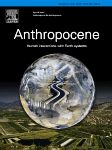Ma et al., 2014
Quantifying an early signature of the industrial revolution from lead concentrations and isotopes in soils of Pennsylvania, USA
Lin Ma, Jasper Konter, Elizabeth Herndon, Lixin Jin, Grit Steinhoefel, Diego Sanchez, Susan Brantley (2014)
Anthropocene 7:16-29
-
Shale Hills, INVESTIGATOR, COLLABORATOR
-
Shale Hills, INVESTIGATOR
-
Shale Hills, INVESTIGATOR, COLLABORATOR
-
National, Eel, Luquillo, Shale Hills, INVESTIGATOR, COLLABORATOR
Abstract
During the early industrial revolution, mining and smelting of ores and coal combustion released significant amounts of lead (Pb) into the atmosphere. While many researchers have documented high Pb concentrations in topsoils due to gasoline combustion between 1940s and 1980s, little work has focused on the extent of Pb and other heavy metal deposition into soils during the early industrial period. Here, we report Pb, cadmium (Cd), and zinc (Zn) concentrations and Pb isotope ratios of soils, sediments, parent bedrock, and waters collected from a small, currently pristine watershed (Shale Hills Critical Zone Observatory) in Pennsylvania (United States of America). Our results show that Pb in the soil comprises an addition profile, i.e. more Pb is present in the soil than is present in the equivalent parent bedrock. All three investigated soil profiles at Shale Hills on the same hillslope have Pb inventories (∼400–600 μg cm−2) attributed to atmospheric deposition. Cd and Zn concentrations in these soils show similar addition profiles due to atmospheric deposition. Based on Pb isotopic ratios, the most likely source of the added Pb is coal burning and ore smelting during local iron production in the early 19th century, roughly coincident with the construction of the U.S. transcontinental railroad. Mass balance and diffusive transport modeling were used to quantify Pb deposition rates and redistribution. These model results are consistent with the hypothesis that from ∼1850s to 1920s, coal burning and ore smelting in local iron blasting furnaces significantly increased the local Pb emissions so that Pb deposition rates in soils were in the range of 6–10 μg cm−2 yr−1. These values are comparable to Pb deposition rates found in other areas with early and intensive industrial activities (e.g. since the ∼1860s in Australia). Our new Pb, Cd, and Zn concentrations and Pb isotope results, in combination with the previously observed manganese (Mn) enrichment at Shale Hills, document that early industrial point sources contaminated local soils with metals that remain even today in topsoils with large sorption capacities. Where these metals are retained, their depth profiles provide a mean to infer the history of metal additions and redistributions.
Citation
Lin Ma, Jasper Konter, Elizabeth Herndon, Lixin Jin, Grit Steinhoefel, Diego Sanchez, Susan Brantley (2014): Quantifying an early signature of the industrial revolution from lead concentrations and isotopes in soils of Pennsylvania, USA. Anthropocene 7:16-29. DOI: 10.1016/j.ancene.2014.12.003
 This Paper/Book acknowledges NSF CZO grant support.
This Paper/Book acknowledges NSF CZO grant support.
Explore Further





